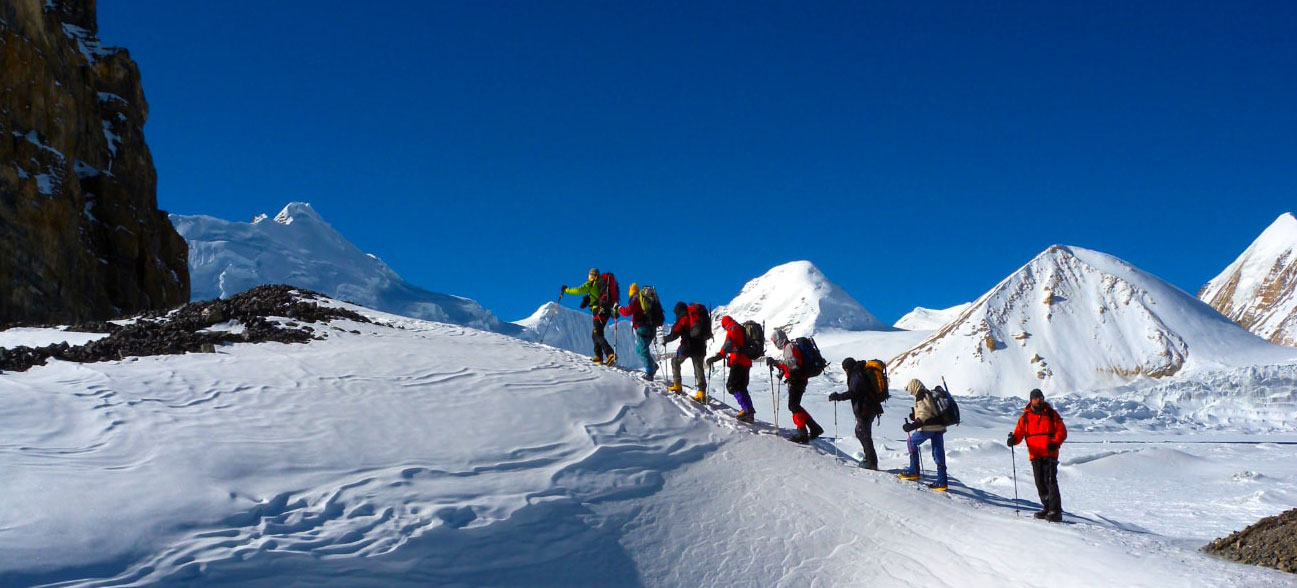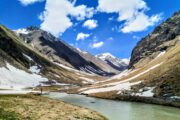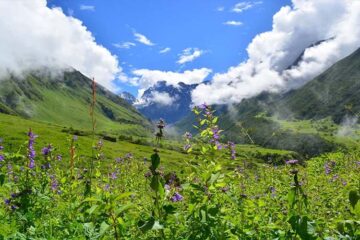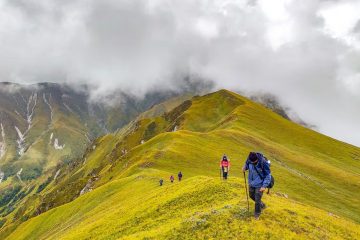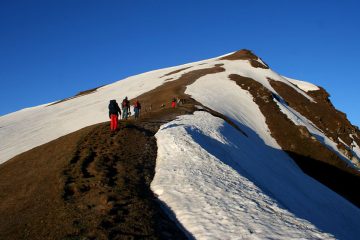The borasu Pass Trek
Region :- Uttarakhand
Snow: December to March
Borasu Pass, or Bara-su, is an extremely steep mountain pass. This is situated at the border of Uttaranchal and Himachal Pradesh, alongside the border with Tibet. It became a historical exchange course between the Har ki Dun valley and the Kinnaur valley. It is now not utilized by the locals and is an escapade for trekkers and mountaineers.
The trek begins off-evolved from Taluka and passes through the plush Har ki Dun valley. Har ki Dun is a picturesque valley inside the Garhwal Himalayas, surrounded by mind-blowing Himalayan peaks and dense forests flocked with colourful birds and wild life. The trek begins with the aid of following the boisterous Har ki Dun Ganga and ends with the huge Baspa River. One can live outside the Forest Rest House in entertainment or camp close to Har ki Dun Ganga. Also, it is possible to camp close to the lovely glacial lake at Maninda Tal, some km from Har ki Dun.
The path passes through glacier moraine, steep slim ridges, sheer vertical snow slopes, and boulder fields. All in all, it’s a beautiful and nerve-wracking trek—a beautiful blend of backwoods and great meadows, full of spurting rivers and large glaciers, with a view of snow-capped peaks and big boulders.
Borasu Pass is one of the many passes that link Uttarakhand and Himachal Pradesh. The Tons River Valley and the Baspa River Valley.
Ever heard of Borasu Pass trek?
Every year lots of trekkers from around the world come for Har Ki Dun trek. It is one of the most beautiful all season treks. However, very few know that if you continue on the same trail further, you can cross into Himachal. The pass which you will be using to do so is known as “Borasu Pass“. It connects Tons Valley in Uttarakhand with Baspa Valley in Himachal. Trek to Barasu Pass offers the true promise of adventure. It is considered a strenuous trek, with pass located at a high altitude of 5360 M. The trek starts from Lovely “Taluka” Village and goes via villages of Gangaad, Dhatmir, Seema and Osla until Har Ki Dun. The trek passes through dense forests consisting of chestnut, walnut, willow and chinar trees. The trek from Osla to Har-ki-doon is through terraced mountain fields, lush green grassy patches, and thick coniferous forests The trail from Har ki Dun to Chitkul (In Himachal) covers all kinds of landscapes that may require the use of some technical equipment too. Being on the border of Indian Himalayas the pass is very close to Tibet. The Borasu Pass trek is meant for experienced trekkers only due to its taxing trail, boulder sections, multiple glacier crossings infested with crevasses, steep ascents and descents. The best months for the Borasu Pass Trek is May, June, Late-September and October.
Day 1- Arrive in Sankri
Day 2- Sankri to Seema via Taluka
Day 3- Seema- Har ki Dun
Day 4- Harkidun to Moninda Lake (5-6 kms)
Day 5- Moninda Lake – Borasu Pass –Camp 1
Day 6- Camp 1 – Doaria Camp Ground
Day 7- Doaria Camp - Chitkul
.
Day 1- Arrive in Sankri
Report to Sankri by 3 PM. Sankri is 185 km away from Dehradun. You can get a shared taxi or public ship to Sankri early in the morning from Dehradun bus stand. It will take 7–9 hours in order to attain Sankri from Dehradun. Spend the night in a hotel or guest house.
Day 2- Sankri to Seema via Taluka
early morning force from Sankri to Taluka in a taxi. Taluka is the place to begin our trek. After breakfast in Taluka, we are able to start hiking with packed lunch to Seema (2260m) on an excellent floor through thick forests of chestnuts, walnuts, willows, chinars, and a whole lot of conifer trees, with some waterfalls on the way. You may want to choose between the steep climb of Dhaatmeer village or simply trek alongside the Karmanasha stream. Both the routes meet at Gangaar village.Reach Seema Camps with the aid of a little past due afternoon. Overnight, we live in tents.
Day 3- Seema- Har ki Dun
The path from Seema begins at the proper left of the valley and continues beyond the fields observed by crossing an ageing bridge over the river Rupin to the proper right of the valley.The path now ascends, moving beyond via fields and pastures with huts. The coniferous flowers on the other side of the valley are spectacular and very cute.The path climbs to the ridge regionally named as Kalkatti Dhar, from which the path traverses to offer you a superb view of Har Ki Dun.
From right here to begin with, the path climbs progressively and later steepens in instances, moving beyond via stunning meadows to the campsite at Har Ki Dun. The campsite is via the small stream, with the peaks of Har Ki Dun and Swargarohini towering above. Overnight inside the tents
Day 4- Harkidun to Moninda Lake (5-6 kms)
Cross the wood bridge near the Har ki Dun Forest Rest House and follow the dust path closer to the main road to a lush, unexplored valley. Hata Peak (simply at the back of the wooded area relaxation house) and Swargarohini Peak are prominently visible from here. Continue along the path, which then passes through large boulders. When the tree line ends, you notice a large valley with a circulation coming from Morinda Tal. Walk up the Tal and set up camp on its side. Soak in the views of magnificent snow-capped peaks and lush, unexplored meadows.
Day 5- Moninda Lake – Borasu Pass –Camp 1
Today we go to the byskip. Since the trek might be hard, we are able to begin early in the morning to have the gain of time at hand. In the morning, the peaks turn golden because the first rays of sunlight fall on them. Borasu glacier and Saunbhera campsite may be visible down below. Begin on foot at the slow snow slope in the direction of the by-ski. We walk for about eight kilometres to reach the by-pass. The very last ascent to the by-skip is boulder and scree strewn. After crossing, we descend to the alternative side. Camp overnight.
Day 6- Camp 1 – Doaria Camp Ground
The trek is straightforward via the valley and the perspectives nowadays will hold your cameras busy. We trekked 10 km to reach Doaria tenting grounds. The trek is first of all to the Baspa river mattress, after which we cross it to attain the tenting grounds. Overnight in camp.
Day 7- Doaria Camp - Chitkul
After every week of residing in the desert nowadays, we are able to see civilization. Todays trek is 10 km, which takes approximately 8-nine hours. This is one of the pleasant walks on this trek. The Walk is below the colour with a mild gradient. Overnight in Chitkul Village. Trek ends here. You may also plan to go back the following day.
.
By Air:-
Dehradun’s Jolly Grant Airport is located about 20 km from the city. You will find a daily flight from Delhi to Dehradun.
Taking the train:
Take the overnight train to Dehradun from Delhi.
- Nandadevi Express-Departure at 11:50pm; Arrival at 5:40am
- Dehradun Express-Departure-9:10pm; Arrival-5:00am
By Bus:-
From Delhi’s ISBT Kashmere Gate, a regular bus service from Delhi to Dehradun is available.
Includes
- Meals during the trek
- Dinner on arrival day in Sankri.
- Forest Permits/Camping Charges (only if availing transportation through A1 Himalayas). Only up to the amount charged for Indian Nationals is included.
- Tents, sleeping bags, mats
- Safety equipment includes static rescue rope, seat harness, carabiners, pulleys,
- Trek guide, cook, helpers, porters, & mules for carrying common luggage.
- The Services of a Certified Trek Leader
Excludes
- Meals during road journeys
- Transportation from Dehradun to Sankri and back to Dehradun.
- Carriage of personal bags during the trek
- Any kind of insurance
- Any expense of a personal nature.
- Any expense not specified in the inclusion list
1) Trekking Shoe/Snow Shoe
2) Rucksack/Back Pack
3) Rucksack cover (Waterproof)
4) Daypack/Knapsack
5) Undergarments/Innerwear
6)Woolen socks
7) Woolen gloves
8) Waterproof gloves
9) T-shirt
10) Trek pants
11) Camp sandal
12) Balaclava/Woolen skull
cap/Monkey Cap
13) Sun cap/Wide-brimmed
Hat/Bandana
14) Walking Sticks/Trekking
Poles/Ski Poles
15) Heavy Jacket
16) Windproof Jacket/Wind
Cheater
17)Raingear/Poncho/Waterproof clothing
18) Water bottle/Hydration pack
19) Sunscreen lotion
20) Sunglasses
21) ChapStick/Cold &
Moisturizing cream
22) Toothbrush and toothpaste
23) Towel
24) Hand sanitizer
25) Tissue roll ( Toilet)
26) Anti Fungal Powder
27) Torch/Head Lamp with extra batteries
28) Knee cap
29) Camera with extra cells
30) Dry food items
31) Personal first-aid kit
32) Medicines (This is a simple
guide line and a doctor’s
consultation is recommended.)
Altitude is a risk. Before you begin the trek, you should be aware of the effects of high altitude on your body. Acute Mountain Sickness (AMS) symptoms include a moderate headache, nausea, and overall discomfort.
Reponse: If you have any of these symptoms, notify the trek leader immediately and follow his advice. To deal with the scenario, each campsite contains a stretcher, a fully prepared first aid kit, and oxygen cylinders.
Weather Risk : No one can guarantee snow, rain, or sunlight, even if we keep a constant eye on the weather. Please keep in mind that your safety is our primary priority, and if the weather isn’t cooperating, we won’t leave the campsite.
Response: The choice to go or wait for better weather will be made solely by the Trek Leaders and Guides.
Risk: Injury is a possibility. While trekking across difficult terrains, minor injuries such as calf sprains, bruising, and other minor ailments are prevalent. Serious injuries, such as fractures or significant cuts, are quite uncommon.
Response: All of our Trek Leaders are trained in wilderness first aid. They’ve been taught to deal with emergencies and have a well-stocked first-aid equipment to deal with minor injuries. In the event of major injuries, the patient is carried to the nearest road-head on a stretcher and taken to the nearest medical facility.
DO’S AND DON’TS ON A TREK
1. Alcohols or any other intoxicating products ‘’STRICTLY PROHIBHITED’’
during the trek.
2. Always pay heed to the trek guides or instructors.
3. Try not to leave the group under any circumstances.
4. Avoid trekking during the nights as it is extremely dangerous.
5. Avoid using earphones as that might hinder your hearing.
6. Do not participate or encourage littering of the places in any form.
7. While visiting the local villages and tourist sites, obey the local guidelines
and instructions.
8. Do not harm or interrupt the local sentiments of the places.
IMPORTANT:
Your safety is of paramount concern while traveling with A1 Himalayas.
Please note that your leader has the authority to amend or cancel any part of
the itinerary if it is deemed necessary due to safety concerns. Since adventure
entails traveling in remote mountainous regions, we cannot guarantee that we
will not deviate from it. Weather conditions, health condition of a group
member, unexpected natural disasters, etc., can all contribute to changes in
the itinerary. The leader will try to ensure that the trip runs according to plan,
but please be prepared to be flexible if required.

